Last Updated on by Mitch Rezman
Why are those feathers on the cage floor? Is it plucking, molting, or over-preening?
We received an email from a subscriber of Sunday Brunch that I am sharing with you below:
12/16/2022 We have a really big ASK from our readers.
Kim, the original companion to Bandit in the story below.
She’s reaching out for a Christmas miracle and would like to speak to Carl, Bandit’s companion who she rehomed him to.
Carl if you are reading this or anyone that has information on Bandit’s current whereabouts please respond to [email protected] so I can connect the two.
I recently adopted a 15-year-old Severe Macaw whose previous owner had a terminal illness. I could tell the Macaw had been taken care of meticulously from the written records of her care from Hatch Papers to recent complete blood panels however I never had the opportunity to question the previous owner concerning details of ‘Bandit”.
I knew the moment I saw her that I wanted her as I owned a Severe 30+ years ago and have known several over the years but none as sweet as this little girl.
What’s the Difference Between Feather Preening, Plucking & Molting?
We spend at least an hour each day cuddled up and grooming each other, over the last month I finished assisting in the removal of cuticles from her new feathers and thought she was finishing a molt but in the last ten days, she has begun to lose a large number of feathers from down. Tertiary flights, a couple of tail feathers and everything in between. Some come out during our preening sessions but most are found in her cage.
She receives a well-rounded diet of fruits, veggies, seeds and pellets which I prepare twice daily along with four others who own my heart and soul, all rescue kids.
I am concerned about the beginning of a plucking problem since Bandit is new to our family even though she seems to be very well-adjusted and happy.
Are there any Tell-Tale signs to differentiate between Preening with Molting and Plucking? Any advice you can offer or things to look for that might settle my mind would be appreciated.
Thank You for your Time and Advice,
Carl B
This problem certainly is in the minds of other adoptive parrot parents and here is my advice:
Let’s look at the three ways parrots can lose feathers and how to deal with each.
Molting:
When a bird molts, it loses feathers in a symmetrical pattern. This means that if a primary flight feather on the left side molts, the matching one on the right side will molt at the same time or within a day or so.
The tertiary flight feather, or inner wing feathers, molt first and the pattern moves out the wing. Tail feathers will molt in the same pattern and then the contour feathers covering the body molt along with the down feathers, those fluffy inner feathers. Each feather is replaced quickly but at times the bird can look a bit ragged. There should never be a bald spot during a molt.
All this is nature’s way of preserving the ability of the bird to fly while replacing feathers with new ones. The molt begins based on a complex combination of hormones and environment.
Over-grooming:
Every day a healthy bird spends time grooming its feathers. This removes dander and the keratin sheaths of new feathers growing in. Those birds that have a preen gland (the uropygial gland) located at the base of the tail will rub oil on their beaks and spread it over the feathers. The vast majority of birds commonly kept as companion birds have this gland. The oil on the feathers is what makes a bird nearly waterproof.
Some birds, especially when stressed or having a medical problem, will over-groom their feathers, creating a ragged look and likely breaking some feathers. This habit can lead to plucking, the last subject we will look at.
A parrot-like Carl that has lost its human and been placed in a new home can mourn the missing human and experience stress due to the presence of other birds (if it was an only-bird before). Some random feathers can be lost due to over-grooming but it is not likely to happen in the same pattern of feathers as in a molt.
A parrot that is over-grooming should have support by daily giving a good multivitamin and mineral supplement as well as an anti-stress supplement like Nekton RELAX supplement.
If the air is dry, frequent opportunities to bathe or shower can help as well as items to prevent boredom like foraging toys, climbing toys, wood toys to chew, shreddable toys, and other attractive, interesting toys.
Arrange the cage so that the bird has a screen of toys in one area to hide behind and arrange the other items in the cage so that the bird has space to move around but has something nearby to play with. Some parrots love to sleep in a birdie bed and feel secure at night using it. If the parrot seems to like television or music, leave this distraction on when the bird is alone during the day.
It is important to address over-grooming — the most likely thing Carl is doing — before it becomes a real habit or progresses to plucking. It is much easier to stop at this point than it is if it progresses to plucking. It is also important to have the bird visit an avian vet to be sure a health problem is not causing or adding to the over-grooming.
Plucking:
Plucking is the act of a bird purposefully pulling out feathers. It is much like humans who cut themselves because the pain caused by yanking a feather out releases endorphins in the brain of humans or birds.
A depressed bird will feel different, even happier, due to the release of endorphins so it can easily become like an addiction. Plucking will leave bare spots where the feathers were pulled out and can even result in a near-naked bird. Long-time plucking can damage feather follicles so that feathers will never regrow.
Plucking can be addressed in the same ways as over-grooming but it is a much harder habit to break. A plucking parrot should definitely visit a vet to see if health may be an issue.
If no health problems are present, the second most likely cause is boredom, but in Bandit’s case, it may be depression due to the feeling of loss of their former home and human. A plucking parrot needs the same supplements as an over-grooming bird, but should also have a supplement for feather growth like Nekton Bio.
Place a plucking bird in the area of the home where it gets the most attention and where activities occur. It could be a good idea to place the new bird away from any existing parrots until it adjusts to its new home.
We wish Carl and Bandit success in stopping the over-grooming which is what I think is happening. By looking at the feathers lost, you can in a few days see if a molt is a cause but even then adding vitamin and mineral support as well as a calming supplement is a good idea. From Carl’s email it doesn’t sound like Bandit is plucking — at least not yet — but she should be watched to see if you see the bird actually removing feathers forcefully.
Which type of macaw is preferred by the reader?
When it comes to choosing a macaw, the preferred type depends on various factors, including personal preference and the available setting. If you have limited space in your home or apartment, a mini macaw would likely be the best option for you. Mini macaws are smaller in size but still possess the vibrant colors and playful personalities that macaws are known for. They are more compact and require less space, making them easier to accommodate in smaller living areas.
On the other hand, if space is not a constraint for you, then the decision becomes more about your personal preference between mini and large macaws. Large macaws are majestic birds with impressive wing spans and striking appearances.
They possess a commanding presence and tend to have louder vocalizations compared to their mini counterparts. If you enjoy their impressive size and are prepared to provide a larger living area and more extensive care, a large macaw might be the perfect choice for you.
Ultimately, the decision between a mini macaw and a large macaw rests on your own preferences, available space, and ability to meet their specific needs. Consider factors such as your living environment, the time and effort you can dedicate to their care, and the level of interaction and noise you are comfortable with. By considering these aspects, you can determine which type of macaw is preferred by you, ensuring a harmonious and fulfilling companionship with your feathered friend.
What are the advantages of choosing a mini macaw over a large macaw?
Choosing a mini macaw over a large macaw comes with several advantages. Firstly, mini macaws require less space, making them an ideal choice for individuals and families living in apartments or smaller dwellings. Their smaller physical size allows them to comfortably reside in smaller cages, saving valuable living space.
Additionally, mini macaws have a smaller appetite compared to their larger counterparts. They consume less food and water, which not only means less expense but also fewer trips to the pet store for owners. This can result in significant cost savings over time.
Moreover, mini macaws are often favored due to their manageable size and weight. Handling and caring for them is generally easier and less physically demanding compared to large macaws, which can be more challenging for some owners.
In summary, the advantages of choosing a mini macaw over a large macaw include their ability to thrive in smaller living spaces, their lower food and water requirements, and their easier handling and care.
These factors can make mini macaws a more practical and convenient choice for individuals and families seeking a pet bird that fits their lifestyle and space limitations.
Are mini macaws intelligent?
Mini macaws are incredibly intelligent birds, despite their small size. They possess a remarkable ability to learn and understand human speech, often picking up full phrases simply by listening to people in the household. Their intelligence extends beyond mere mimicry; even without formal training, mini macaws are likely to learn words and phrases from hearing their owners and other family members speak.
Furthermore, owners have the opportunity to enrich their mini macaw’s intelligence by teaching them basic tricks like handshakes or dances. These birds are a testament to their species’ intelligence and capability for learning and interaction.
What are the different species of mini macaws?
There are several species of mini macaws, each with its own unique characteristics. Here are some of the different species:
1. Chestnut-fronted (Severe) Macaw (Ara severa): This is one of the largest mini macaws, primarily green in color with distinctive red and blue patches on its wings.
2. Golden-collared Macaw (Primolius auricollis): Mostly green in appearance, this macaw stands out with a vibrant yellow collar on the back of its neck that becomes more prominent as the bird ages.
3. Blue-winged (Illiger’s) Macaw (Primolius maracana): Native to eastern and southern Brazil, this macaw features beautiful blue wings.
4. Blue-headed (Coulon’s) Macaw (Primolius couloni): This species showcases a blue-colored head, flight feathers, and primary coverts.
5. Red-bellied Macaw (Orthopsittaca manilatus): Easily distinguished by a large maroon patch on its belly, this mini macaw stands out among the others.
6. Red-shouldered Macaw (Diopsittaca nobilis): The smallest of the mini macaws, this adorable bird boasts a compact size and is often considered a popular pet.
Should I choose a mini or regular-sized macaw?
When deciding between a mini or regular-sized macaw, there are several factors to consider. Both options offer the companionship of an affectionate and intelligent bird with beautifully colored plumage. However, understanding the unique characteristics of each variety will help you make an informed decision.
Firstly, let’s clarify what is meant by a “mini macaw.” Mini macaws are a smaller-sized group within the macaw family, specifically in the tribe Arini. These birds typically measure less than 20 inches from beak to tail. In contrast, any macaw exceeding this size is classified as a regular or large macaw.
If you have limited space in your home or live in an apartment, a mini macaw might be the better choice. Their smaller size makes them more manageable and suitable for smaller living spaces. On the other hand, regular-sized macaws require more room to comfortably move and spread their wings.
Another factor to consider is your personal preference. While mini macaws possess the same traits as their larger counterparts, their compact size may appeal to those who prefer a smaller bird. Regular-sized macaws, however, have a majestic presence and can make a striking visual impact.
Additionally, your lifestyle and the amount of time you can dedicate to your macaw should be taken into account. Mini macaws generally have similar care requirements to regular-sized macaws, such as a proper diet, socialization, and mental stimulation.
However, regular-sized macaws may require more physical activity and mental enrichment due to their larger size and energy levels.
Ultimately, the choice between a mini or regular-sized macaw depends on your living situation, preferences, and ability to provide for the specific needs of each bird. Take the time to research and understand the unique qualities of both varieties before making a decision.
Consider consulting with an avian expert or visiting a reputable breeder or avian rescue to gather more information and interact with the birds in person.
What is the opinion on the ease of owning different bird species?
There is a difference in opinions when it comes to the ease of owning various bird species. Personally, I believe that cockatiels are one of the easiest birds to take care of. However, it is important to remember that individual birds may have their own unique personalities and needs.
Sometimes, people think that once they have mastered taking care of a smaller bird, they should move on to a larger one. However, I think it is important to appreciate and cherish each bird for who they are.
For me, I initially got a cockatoo because it was my partner’s preference, but I was perfectly content with having cockatiels as my only birds. That being said, I do love my cockatoo dearly. He brings joy and amusement to my life every day. However, I must admit that he is not an easy bird to handle.
When it comes to suggesting a particular bird species, it really depends on what catches your interest and why. It is crucial to remember that any bird has the potential to bite, although the severity may vary based on the size of their beak. I once had a lovebird who, despite being small, managed to give me a slight injury with a bite. So, if you are not comfortable handling a large bird, it is best to avoid them. Personally, I prefer smaller birds as they are more manageable for me.
Discovering new bird species can be exciting. For example, I recently came across Rosy Bourkes and was amazed by how sweet, calm, and gentle they are. They could easily be contenders for the title of the easiest bird to care for. However, it’s important to note that even seemingly easy birds like finches and canaries require some level of bird behavior knowledge and care, albeit less hands-on.
In summary, the ease of owning different bird species really depends on the individual bird and your own comfort level. It is essential to do proper research and seek guidance to understand the specific needs and behaviors of any bird species you may be considering as a pet.
Who are the individuals participating in the conversation?
In the conversation, there are multiple individuals who are expressing their thoughts and experiences regarding different bird species. Some of the participants include Xoetix, April, Tyrion, sunnysmom, Fickle, and others. They all have their unique perspectives and preferences when it comes to birds.
Xoetix appreciates budgies and considers them to be excellent recruiters for a cult. They acknowledge the charm and attractiveness of budgies.
April finds joy in the cleanliness of budgies, particularly admiring their tiny and easy-to-clean droppings. She also compares the cleanup process of budgies to that of other parrot species, mentioning that budgies are easier to handle in terms of waste management.
Tyrion has a slightly different viewpoint, suggesting that the ease of taking care of a bird depends on the individual and their personal connection with the bird. They express their love for their own Grey and Amazons, considering them easy to handle. Tyrion believes that the bond with the bird determines the ease of caring for them.
sunnysmom shares their opinion that cockatiels are the easiest bird species overall. They note that while individual birds may differ, cockatiels as a whole are considered easy to handle.
They caution against thinking that mastering a smaller bird automatically means one should move on to a larger bird, and emphasize that each bird should be appreciated for its unique qualities.
Fickle comments on their initial impression of Rosy Bourkes, highlighting their surprise at discovering how sweet, calm, and amazing these birds are. They mention that while finches and canaries are the easiest birds to care for on a more hands-off basis, understanding the behavior and needs of Bourkes requires a calm owner with bird behavior knowledge.
Throughout the conversation, these individuals primarily discuss their experiences with budgies, cockatiels, and other bird species, sharing their opinions on ease of care, personality traits, and the importance of finding a bird species that resonates with one’s own preferences.
What are some factors to consider when adopting a bird?
When considering adopting a bird, there are several important factors to take into account. Firstly, it’s crucial to understand that all parrots have the potential to bite.
Their inclination to bite may vary, and individual experiences can differ greatly. Generally, older rehomed birds who have settled into their new environment may be the easiest to care for as they are content with a simple routine of eating and playing.
Another factor to consider is the potential harm caused by cockatiel dust, specifically for new world species like conures and macaws. It’s essential to keep these species separate from cockatiels to prevent any adverse effects.
It’s worth noting that no matter the species, any bird has the capability to bite. The severity of the bite will depend on the size of the bird’s beak. While a lovebird may not cause significant damage, their bite can still be painful.
Aside from these considerations, it is important to research and understand the specific needs and temperament of the bird species you are interested in adopting. Factors such as diet, socialization requirements, and exercise needs should be taken into account to ensure you can provide a suitable and fulfilling environment for the bird.
Overall, adopting a bird requires careful consideration of these factors, as well as a commitment to providing a safe and nurturing home for your new avian companion.
Does anyone have any experience or thoughts on other parrot species from cockatiel owners?
Certainly! When Fickle started the thread, they were interested in hearing from cockatiel owners who have experience or thoughts on other parrot species.
Mizzely acknowledged that all parrots have the potential to bite intentionally and mentioned that there would be numerous answers given the diverse nature of parrots. They highlighted that in their personal experience, older parrots who have been rehomed tend to be the easiest to care for as they are content with a simple life of eating and playing.
Sunnysmom contributed to the discussion by stating their opinion that cockatiels, in general, are the easiest bird species to care for. However, they made it clear that individual birds’ personalities can vary, meaning that even within the same species, some birds may be easier or more challenging to handle.
Overall, the responses indicated that while cockatiels may be perceived as easy birds to care for, different parrot species can vary in terms of temperament and care requirements. It is essential to consider the specific needs and characteristics of each individual bird, regardless of their species, for a successful and fulfilling ownership experience.
Is there a parrot species that is fun, loving, and comical but won’t potentially bite with intent or rip a finger off?
When it comes to parrots, finding one that is fun, loving, and comical while not potentially biting with intent or causing harm requires careful consideration. While there may not be a specific parrot species that guarantees absolutely no biting or aggression, there are some factors you can keep in mind.
Firstly, older rehomed parrots tend to be more laid-back and content with a simple life of eating and playing. These birds have already gone through their developmental stages and may be more settled in their behavior, reducing the likelihood of aggressive tendencies.
Secondly, each parrot has its own unique personality, which can greatly influence their behavior. Some parrots naturally have a more docile nature and are less prone to biting. However, it’s important to remember that behavior can still vary significantly even within the same species.
Additionally, providing proper training, socialization, and environmental enrichment for your parrot can play a crucial role in minimizing the chances of aggressive behavior. This includes spending quality time with your bird, interacting with them positively, and ensuring they have plenty of mental and physical stimulation, such as toys and foraging activities.
It’s also important to note that parrots have different beak sizes, strength, and capabilities. While any parrot, regardless of species, can potentially inflict a bite with intent, larger parrots like macaws and cockatoos may have a greater ability to cause serious harm compared to smaller parrots like cockatiels or lovebirds.
Lastly, some parrot species produce a fine dust from their feathers that could potentially be harmful to other parrots, particularly those from New World species like conures and macaws. If you are considering having multiple parrots from different species, it’s vital to research and take necessary precautions to prevent any potential health risks.
In conclusion, while it is challenging to find a parrot species that guarantees no potential for biting or aggression, factors such as the individual parrot’s age, personality, and proper care can influence their behavior. It’s crucial to approach parrot ownership with patience, understanding, and a commitment to providing a nurturing and stimulating environment for your feathered friend.
What is the next step up in parrots after budgies, rosy bourke parrots, and cockatiels?
When it comes to moving up from budgies, rosy bourke parrots, and cockatiels, the parrot kingdom offers a variety of options. Choosing the next step up depends on your preferences and level of commitment. While there are many possible answers to this question, I’ll provide some insights to help you make an informed decision.
One potential step up in parrots from the aforementioned species could be conures. These playful and often colorful birds make great companions and are known for their energetic personalities.
Conures come in different species, such as the Green Cheek Conure, Sun Conure, and Nanday Conure, each with its own unique traits. They are generally more active and require more mental stimulation than smaller parrots like cockatiels. Conures can be a wonderful choice if you are looking for a highly interactive bird that can keep you entertained with their antics.
Another option to consider is the lovebird. These small parrots are known for their strong bond with their owners and their playful nature. Lovebirds come in various species, including the Peach-faced, Fischer’s, and Masked lovebird.
They are intelligent birds that can be easily trained and can delight you with their inquisitive and affectionate behavior. Lovebirds thrive on social interaction and, with proper care and attention, can become a loyal and entertaining addition to your household.
If you are seeking a parrot with a larger size and an impressive set of vocal abilities, you might be interested in exploring the world of African Grey Parrots. These highly intelligent birds are often regarded as one of the best talking parrot species.
African Greys have the cognitive abilities to understand and mimic human speech, making them exceptional companions. However, they require extensive mental and social stimulation to thrive, so be prepared to provide them with plenty of enrichment activities and interaction.
Ultimately, the next step up in parrots after budgies, rosy bourke parrots, and cockatiels relies on your personal preferences and dedication. Proper research and consideration of the specific needs, personalities, and care requirements of different parrot species will enable you to find the perfect match for you and your lifestyle.
What is the opinion on the value of cockatiels as companions?.
“13. TIME.. Your parrot need your undivided attention for a considerable amount of time. Each species and each bird is different. A Cockatiel may only want 20 mins 3x a day (I can tell this by when he starts getting nippy), but a Cockatoo is happy only when they can be your right arm pal for hours at a time.
There is bath time that needs to take place in the morning to give the parrot time to dry before nightfall. This can be a trying feat if birdie doesn’t favor bathtime, but it is a necessity. Every morning you must fix breakfast, change papers, and spend some quality/quantity time.
Does your morning schedule allow for this? Are your evenings filled with school activities, work from the office, college courses, etc? PLEASE reconsider the notion to bring a parrot into your home if you can’t spend quality and quantity time with your parrot!
20. ENTERTAINMENT/LOVE/JOY/HAPPINESS.. A happy parrot makes a happy human. What a parrot provides in return for putting up with them is greater than you can ever imagine. Life with a parrot is never the same as the day before. We are willingly owned by our birds and our life revolves around our birds. It is a commitment we gladly make for the rest of our lives. If you can’t make a lifelong commitment to a parrot, get a pet with a shorter lifespan.
While the previous excerpt emphasizes the importance of time and attention required for parrots, it is also worth considering the value that different parrot species bring as companions. Cockatiels, for instance, are known for being relatively low-maintenance birds that may only require shorter periods of dedicated interaction throughout the day. Understanding the specific needs and preferences of your feathered friend is crucial, as each species and individual bird may vary in their requirements.
Furthermore, it is essential to acknowledge the undeniable joy and happiness that parrots bring into our lives. The love and entertainment they provide are beyond measure, creating a unique and ever-changing bond with their human caretakers. We willingly welcome these feathery companions into our homes, knowing that our lives will forever revolve around them.
The commitment to a parrot is a lifelong one, and if unable to make such a lasting commitment, it may be more suitable to consider a pet with a shorter lifespan.
In summary, while investing time and attention is crucial for any parrot companion, the value of cockatiels as companions is recognized for their relative ease of care and the unique happiness they bring into our lives.”
Written and Approved by the Windy City Parrot content team
Author Profile

Latest entries
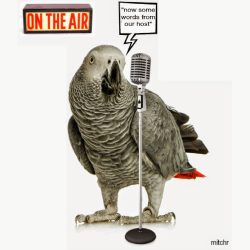 Bird & Parrot CareJune 20, 2025Understanding the Best Way to Use Prevue Pets Mimic Me Voice Trainer
Bird & Parrot CareJune 20, 2025Understanding the Best Way to Use Prevue Pets Mimic Me Voice Trainer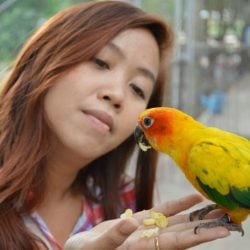 Bird BehaviorJune 6, 2025How Do I Keep My Parrot From Dumping His Food Every Day?
Bird BehaviorJune 6, 2025How Do I Keep My Parrot From Dumping His Food Every Day?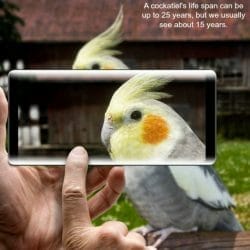 Birds & LightingMay 16, 2025I Am Seeking Clarity About Lighting for My Birds Cage
Birds & LightingMay 16, 2025I Am Seeking Clarity About Lighting for My Birds Cage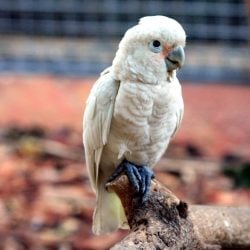 Bird RescueApril 29, 2025How Do We Re-Home a 17 yr Goffin Cockatoo?
Bird RescueApril 29, 2025How Do We Re-Home a 17 yr Goffin Cockatoo?
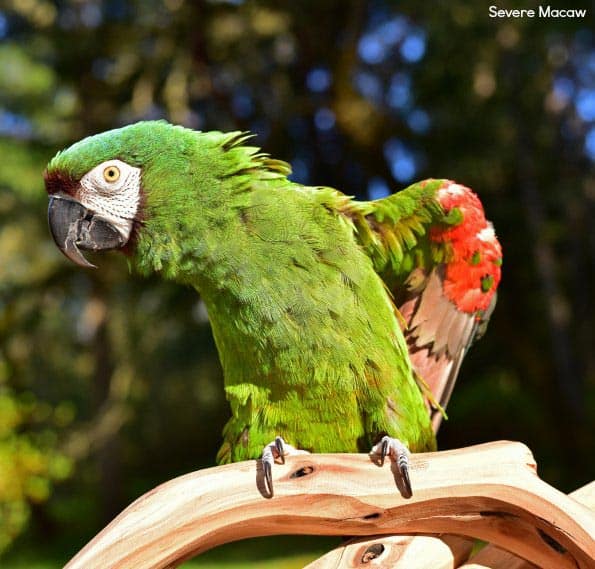




Birds Unlimited
30 Oct 2016Your picture of a Severe Macaw is actually a Military Macaw, Ara militaris not Ara severa
WindyCityParrot
30 Oct 2016thank you for the correction Birds Unlimited – we have updated the image https://windycityparrot.com/wordpress/2016/10/27/carls-severe-macaw/
WindyCityParrot
30 Oct 2016Hopefully Carl will answer you Lisa
[email protected]
18 Dec 2022i was the parront of a severe macaw for 31 years.. i would spend hours grooming my parrot but he also groomed himself. i would also get worried when i foound lots of feathers laying on the bottom of the cage when i thought molting was over. all you need to do is check the birds body for new feathers growing in for instance if you see good tail feathers laying on the bottom of the cage check to see if there are new tail feathers growing in. i think that these old feathers are annoying to the bird and they pull them out on their own. as long as the shaft has no blood in it and is fairly clean i think it is your bird removing old irritating feathers. those little down feathers are eveywhere and i wouldnt worry about seeing them.. make sure your bird is bathing enough to help keep the skin and feathers healthy. sadly my bird died of cancer.